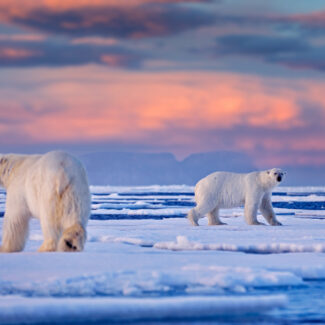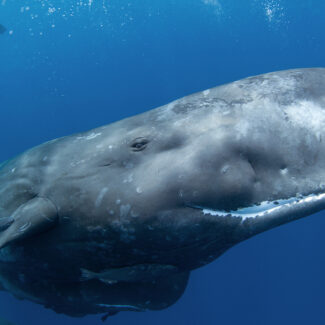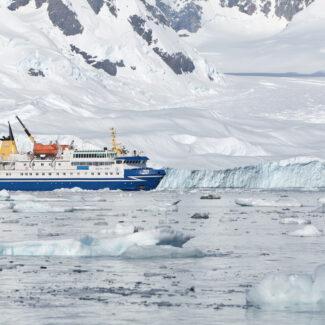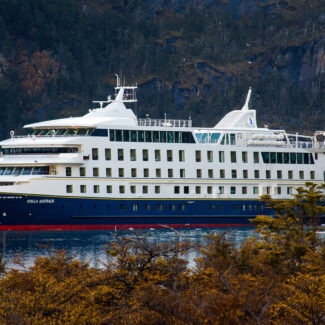8 Facts About The Gyrfalcon: The Arctic's King of the Skies
- (1) They Are the Largest of All Falcons
- (2) They’re Among the Northernmost of All Raptors
- (3) They Come in Three Color Phases
- (4) Gyrfalcon Diet: They’re Adept Bird-hunters, But Also Prey on a Variety of Mammals
- (5) They Occasionally Show Up Far South of Their Usual Range in the Wintertime
- (6) They Sometimes Winter Far Out on the Arctic Sea Ice
- (7) They Don’t Build Their Own Nests
- (8) They’ve Long Been Revered by Humans—Including for Royal Use in Falconry
- Where to See Gyrfalcons
Among the many marvelous exponents of Planet Earth’s bird-of-prey line, the gyrfalcon (pronounced “JER-falcon”, a name derived from the Old Norse word geirr, meaning “spear”) is one of the Arctic and sub-Arctic’s signal predators, and very high on the must-see list of nearly any birdwatcher. Here, evolution has crafted a dazzling avian hunter, long worshipped by falconers and just about a ptarmigan’s worst nightmare.
With immense power and grace, the gyrfalcon reigns supreme over the Arctic, a true marvel of evolution and a testament to the untamed wilderness.
Fast- and direct-flying, garbed in ghostlike plumage that’s sometimes close to pure white, the gyrfalcon—only seen periodically in the more settled latitudes on the southern fringes of its domain—is indeed about as phantasmal and mythic as birds come.
While you may luck out with a glimpse in some snowy wheatfield or frigid seacoast in, say, the northern Lower 48 or southern Canada, venturing into the “gyr’s” true heartland means steering your way to the Far North and its wide-open tundra and back-of-beyond mountain cliffs.
Learn more about this high-latitude phantom with the following eight gyrfalcon facts!
(1) They Are the Largest of All Falcons
Eagles can be much bigger, owls arguably fiercer, hawks and vultures greater masters of the thermals, but you could make an argument (a subjective one, to be sure) that falcons are the epitome of sheer “raptor-ness”: the most exquisitely fine-tuned of the birds of prey.
As Pete Dunne beautifully describes in Hawks in Flight, “Falcons are blade-winged sentinels standing guard in places where distances are measured by the horizon,” and “their mode of hunting is a one-on-one shootout, with all the chips going to the better flier.”
And the giant of the genus Falco is the gyrfalcon. Female gyrs—as in many raptors, significantly bigger than males—can tip the scales beyond four pounds. This makes them as big or even bigger than the largest buteos (the raptor genus that includes such familiar hawks as the North American redtail and the Old World common buzzard). They are notably bulkier, longer, and broader-winged than the peregrine, surely the best-known of all falcons. Gyrfalcon wingspan can reach up to four or so feet across.
Gyrfalcons are part of the falcon subgenus Hierofalco, other members of which include the lanner, laggar, and saker falcons (and perhaps Australia’s black falcon, too). Hierofalcons are thought to have arisen in Africa (still home to lanner and laggar falcons) and spread from that continent into Eurasia and beyond in multiple waves.
Effortlessly dominating the sky with a wingspan of up to 5 feet, the gyrfalcon commands respect as the largest and most powerful falcon on the planet.
(2) They’re Among the Northernmost of All Raptors
Gyrfalcon range reaches farther north than nearly any other raptor, though they are rivaled on this geographic count by the snowy owl (the Arctic range of which is very similar to the gyr’s) and, in fact, by the peregrine falcon, which, in parts of Eurasia, has been known to nest even farther north than the gyrfalcon—though the reverse is true in the North American Arctic (Nearctic).
The typical purview of the gyrfalcon extends from the sub-Arctic—as far south as 51 degrees N on Russia’s Kamchatka Peninsula—all the way up to about 82 degrees N, and includes such extreme Arctic environs as Ellesmere Island and northern Greenland.
In terms of gyrfalcon habitat, the birds prefer wide-open spaces, with tundra being their primary (but not exclusive) stomping-ground.
Soaring above the frozen tundra, the gyrfalcon is a master of adaptation, thriving in the unforgiving Arctic and establishing itself as a true northern survivor.
(3) They Come in Three Color Phases
Three main color morphs or phases of gyrfalcon are known: white-phase, gray-phase, and dark-phase birds, with much gradation between. Gray-phase gyrs are most prevalent, with white-phase birds most commonly recorded in Greenland and dark-phase ones are often seen in Labrador and other parts of northern Canada. This color variation is a result of genetics, with the broad geographical correlation from historic isolation, as opposed to seasonal changes or age—although juveniles tend to be somewhat darker, their adult plumage will still fall within the genetically determined color phases.
The white-phase gyrfalcon is unmistakable, while gray- and dark-phase gyrs may be confused with peregrine falcons. Besides the gyr’s greater size, blunter wings, and longer tail, both gray and dark morphs tend to be paler or duller than peregrine falcons, and also have a less pronounced “moustache” mark on the cheek.
From stark white to dark gray, the gyrfalcon’s plumage has three distinct color phases, with this magnificent white morph a stunning example of their natural variation.
(4) Gyrfalcon Diet: They’re Adept Bird-hunters, But Also Prey on a Variety of Mammals
Gyrfalcons are exceedingly formidable predators, and their quarry is often of the feathered variety. Their “classic” prey, if you will, is ptarmigan, those hardy tundra grouse of alpine and Arctic reaches. But a whole variety of birdlife lands on the gyr’s menu, ranging from songbirds to seabirds, waterfowl, and even other raptors.
Gyrfalcons certainly don’t turn up their noses (err, beaks) at mammalian sustenance, either: They’ll hunt rodents such as lemmings and voles, and also sometimes target Arctic hares—impressively large prey for the bird. Even Arctic-fox kits have been known to fall victim to the swift lethality of the gyrfalcon.
Like other falcons, gyrs are splendidly fast on the wing: They may reach speeds of 130 miles per hour. And while they’ll sometimes stoop (aka dive-bomb) in the manner of a peregrine, gyrfalcons are generally more apt to pursue their prey in horizontal chases. Often they wing along fairly close to the ground, looking to ambush-flush birds into flight; the falcons then immediately accelerate to their lightning-swift top speed, which commonly sees them overtake such notably fleet quarry as wigeons.
Known for its incredible speed and strength, the gyrfalcon is a master of aerial pursuit, adeptly hunting other birds and mammals in its Arctic domain.
(5) They Occasionally Show Up Far South of Their Usual Range in the Wintertime
Although many gyrfalcons spend the entire winter up in their normal Arctic and sub-Arctic haunts, some—especially juveniles—occasionally fly far south this time of year. They are rare but semi-regular visitors to the northernmost reaches of the conterminous U.S., for example: found on the windswept, snow-skeined prairies of Montana and the Dakotas, along the shores of the Great Lakes in the Upper Midwest, and occasionally showing up among the oldfields and seashores of New England and the coastal flats of the Pacific Northwest. Observations farther south than this latitudinal belt are much scarcer, though there are, for example, isolated records of gyrs in south-central California and Oklahoma City. Gyrfalcons are also rare wintertime visitors to the British Isles and such southerly spots in mainland Europe as Spain.
When seasonally residing in more temperate latitudes, gyrfalcons still tend to seek out tundra-like habitat: from grasslands and agricultural fields to open shoreline and coastal zones.
While typically a far northern resident, this magnificent falcon will occasionally journey south in winter, offering lucky observers a rare and unforgettable sighting.
(6) They Sometimes Winter Far Out on the Arctic Sea Ice
While many gyrfalcons, as mentioned, overwinter in the Arctic, far northern populations often migrate short to medium distances southward, and some birds become quite wide-traveling, not necessarily locked down to a particular home range. A 2011 study that analyzed the travels of satellite-tagged gyrfalcon in Greenland outside of the breeding season revealed that some of the raptors head offshore to winter out on the sea ice: sometimes for more than a month at a time. One juvenile female gyr covered nearly 3,000 miles over about 200 days, and more than half of that period she spent at sea between Greenland and Iceland.
Gyrfalcons out on the winter sea ice are likely preying mainly on seabirds and waterfowl (such as sea ducks) around leads, polynyas, and other patches of open water. Interestingly, a similar behavior has been observed in snowy owls, a competitor and neighbor of the gyrfalcon.
Resilient and resourceful, the gyrfalcon is built to endure the Arctic winter, sometimes venturing far out onto the frozen sea ice in search of food.
(7) They Don’t Build Their Own Nests
You can call a gyrfalcon outstanding in many aspects, but nest-building isn’t one of them. These falcons either nest on bare cliff-outcrops and ledges or occupy abandoned nests constructed by other birds, such as other raptors and ravens.
Female gyrfalcons typically lay between one and four eggs or so, and both parents take part in the rearing. The falcons will vigorously defend their nests from potential predators, even good-sized carnivores.
Using radiocarbon-dating of guano, researchers in Greenland showed that some gyrfalcon nests there have been in continuous use for better than 1,000 years—even, in at least one case, more than two millennia!
Though the chicks huddle in a high-up nest, their parents didn’t build it. Gyrfalcons are known for taking over the abandoned homes of ravens or other raptors.
(8) They’ve Long Been Revered by Humans—Including for Royal Use in Falconry
Given the gyrfalcon’s size, speed, and power—not to mention its renowned resilience and survival skills in the extreme conditions of the Arctic—it’s little surprise humans have long regarded it with awe and respect. Among the Iñupiaq, for example, the gyrfalcon is known as Okiotak, meaning “One Who Remains in Winter,” testament to the raptor’s year-round presence.
Its significance to Indigenous Arctic cultures spans both material and spiritual domains, equally revered in oral traditions and ceremonial practices as a messenger of the spirit world, as well as being used as an indicator in traditional ecological knowledge, with population monitoring of this top predator used as a gauge for ecosystem wellbeing.
This veneration hasn’t only been true among those that most extensively share territory with the bird though: Falconers far outside its natural geography rate the gyrfalcon very highly indeed. Such was the hunting prowess of the gyrfalcon and the difficulty in procuring it that, many centuries ago in Europe, Asia, and North Africa, the use of gyrs in falconry was often restricted to royalty.
Prized by royalty for centuries, the gyrfalcon is revered for its power, beauty, and hunting prowess, cementing its status as the most sought-after bird in the sport of falconry.
Where to See Gyrfalcons
Gyrfalcons are not easy birds to see, given their generally very remote haunts and often relatively thin distribution on the Arctic and sub-Arctic landscape. That said, cruises to such destinations as Iceland, Svalbard, Greenland, and the Canadian High Arctic certainly give you the chance to possibly luck out with a glimpse of this swift and regal raptor: a once-in-a-lifetime thrill!
Disclaimer
Our travel guides are for informational purposes only. While we aim to provide accurate and up-to-date information, Antarctica Cruises makes no representations as to the accuracy or completeness of any information in our guides or found by following any link on this site.
Antarctica Cruises cannot and will not accept responsibility for any omissions or inaccuracies, or for any consequences arising therefrom, including any losses, injuries, or damages resulting from the display or use of this information.

































